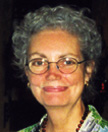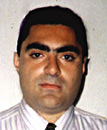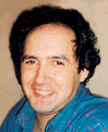|

Autumn 2004 (12.3)
Contributors
 |
This
past summer, Ramiz Abutalibov brought his own personal copy of
the 1943 Italian edition of "Ali and Nino" to our office
in Baku. Like many other Azerbaijanis, Ramiz was concerned about
the true identity of the author who goes by the penname Kurban
Said. Ramiz' genuine interest in all things cultural started
the wheels rolling and via the Internet, we soon began a fascinating
journey that led us to discover that the book had been published
much more widely than we could ever have dreamed - at least,
21[now 29] languages with more than 100 editions or reprints.
Page
54 and following. |
 |
Veteran
librarian Diane Childs of UCLA (University of California at Los
Angeles), who has been on faculty exchanges twice to Azerbaijan,
assisted in the tedious research on the Internet and UCLA data
bases to find editions of "Ali & Nino" by Kurban
Said [Gurban Sayid] that are published throughout the world.
Her expertise in combing the databases and understanding the
intricacies of numbering system of the ISBN (International Standardized
Book Number) helped us to identify 21 [now 29] languages [update:
June 2005, 21 languages], making this book, undoubtedly, the
most widely published work in the history of Azerbaijan. Page
56. (Coming soon) |
 |
Politically
concerned artist Mir Teymur claims that his own ancestors have
lived in Ichari Shahar (Baku's Old City) for the past 800 years.
Maybe that's why he's so committed to the preservation of its
architectural integrity, and to development that preserves, not
destroys, its picturesque character. He's the one who made us
realize that the Old City is more than buildings; it's a living,
vibrant community. For ceramics, watercolor and pen graphics
related to the Old City, contact Mir Teymur: (994-12) 492-8805,
Mobile: (994-55) 777-3738. See
Page 32. |
 |
Farid
Alakbarov is a medical historian who grew up in the Old City
in the 1960s. It was his grandmother featured in this issue -
Khadija Aghabeyli - who got him curious about the Arabic script,
which was the official alphabet in Baku in her day. Farid, who
now does research at Baku's Manuscript Institute found the 14th
century manuscript by the scholar Bakuvi, describing what Baku
was like 500 years ago. Page
46. He also shares segments of his grandmother's diary,
which give us a flavor of the Old City just prior to the Bolshevik
occupation in 1920. Page
48. |
 |
Is
there any artist in Baku who has never painted scenes from the
Old City? We doubt it. But we were particularly attracted to
Mahmud Mahmudzade's watercolor for the front cover. He chose
shades of autumn brown juxtaposed with the eternal green of cypress
trees to embody the old, ageless character of the Old City. In
a dry dusty climate, with its scorching hot temperatures, Mahmud's
brush captures the vitality of objects that have withstood the
test of time. See his works at AZgallery.org.
Contact Mahmud to visit his studio: Mobile: (994-50) 325-0208,
Home: (994-12) 438-6220, Email: ccorona@mail.ru. |
Back to Index
AI 12.3 (Autumn 2004)
AI Home
| Search | Magazine
Choice
| Topics
| AI Store | Contact us
Other Web sites
created by Azerbaijan International
AZgallery.org | AZERI.org | HAJIBEYOV.com
|